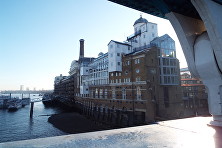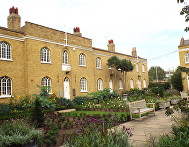





Exploring Southwark and discovering its history


Southwark Fair
Southwark Fair, famously depicted by William Hogarth in his engraving of 1733, shows an exuberant slice of life, a heaving mass of people intent on revelry and entertainment, fun and merry making. The Fair was granted by charter to the City of London by Edward IV in 1462 but its origins went much further back and probably originally held for mercantile reasons.
Hogarth’s engraving shows the tower of St George the Martyr in Borough High Street. This church was demolished a year later and replaced with the current church built in the classical style. The Fair had started life slightly further north around St Mary Overie (Southwark Cathedral) and was also known as Our Lady Fair. It was held on 7, 8 and 9 September to coincide with the Feast of the Nativity of the Blessed Virgin Mary but by the time it reached its heyday in the early 18th Century, it lasted for two weeks. Stalls and booths were erected along St Margaret’s Hill (now a part of Borough High Street) and in the surrounding courts and alleys as far as St George the Martyr and even on the bowling greens of St George’s Fields. Plays were once again performed in the courtyards of inns. The entertainment included theatrical performances, both tragedies and comedies, tightrope walkers, boxing competitions, performing animals, magicians, puppet shows and waxworks, and there were many stalls set up for the provision of refreshments. Some of the stall-holders collected money to help the prisoners in the Marshalsea.
We have first hand accounts from John Evelyn and Samuel Pepys:
“I saw in Southwark, at St. Margaret's Faire, monkies and asses dance and do other feates of activity on ye tight rope; they were gallantly clad à la mode, went upright, saluted the company, bowing and pulling off their hatts; they saluted one another with as good a grace as if instructed by a dancing-master. They turned heels over head with a basket having eggs in it, without breaking any; also with lighted candles " in their hands and on their heads, without extinguishing them, and with vessells of water, without spilling a drop. I also saw an Italian wench daunce and performe all the tricks on ye tight rope to admiration; all the Court went to see her. Likewise here was a man who tooke up a piece of iron cannon of about 400 lb. weight, with the haire of his head onely."
John Evelyn, 13 September 1660
"To Southwark Fair, very dirty, and there saw the puppet-show of Whittington, which is pretty to see; and how that idle thing do work upon people that see it, and even myself too! And thence to Jacob Hall's dancing on the ropes, where I saw such action as I never saw before, and mightily worth seeing; and here took acquaintance with a fellow who carried me to a tavern, whither came the music of this booth, and by-and-by Jacob Hall himself, with whom I had a mind to speak, whether he ever had any mischief by falls in his time. He told me, 'Yes, many, but never to the breaking of a limb.' He seems a mighty strong man. So giving them a bottle or two of wine, I away."
Samuel Pepys, 21 September 1668
The Fair attracted people from all walks of life, from the high class to the low, even royalty, and attracted the highest quality actors and other entertainment. Some companies advertised their forthcoming performances at the Fair. In 1731, Lee and Harper advertised their production of Jeptha's Vow and the Fall of Phaeton which was to take place in their booth on the bowling green behind the Marshalsea. There was to be a variety of singing and dancing in between acts and in addition a pantomime entertainment entitled the Harlot's Progress. Another advertisement described Jeptha's Vow and The Fall of Phaeton, "the whole intermix'd with Comic Scenes between Punch, Harlequin, Scaramouch, Pierrot and Columbine". This latter can clearly be seen in Hogarth's illustration which also shows a large poster for the "most celebrated entertainment called The Siege of Troy" advertised by Lee's Great Theatrical Booth in 1734. Another company, Yeates (Senior and Junior) advertised a performance of the "Ballad Opera" The Harlot's Progress in 1722 "To which will be added Yeates (Junior) Incomparable Dexterity of Hand ... and at a Large Room near Booth, 2 Large Ostriches, lately arrived from the Deserts of Arabia being Male and Female".
A more varied entertainment was advertised in 1733 by Pinchbeck and Fawkes which would:
"Divert the Publick with the following surprising Entertainments at their great Theatrical Room at the Queens Arms joining to the Marshalsea Gate ... The diverting and incomparable Dexterity of Hand, perform'd by Mr Pinchbeck who causes a Tree to grow out of of a Flower-Pot on the Table, which blossoms and bears ripe Fruit in a Minute ... the famous little Posture-Master of nine Years old, who shows several astonishing Postures by Activity of Body ...an amazing Musical Clock made by Mr Pinchbeck, 2 beautiful moving pictures and performs on several muscial instruments ... a curious Machine being the finest Piece of workmanship in the World for moving Pictures and other curiosities ... while the Booth is filling the little Posture-Master will divert the Company with several wonders on the slack rope..."
But despite the fun and the variety and quality of the entertainments, the festivities went hand in hand with danger, vice and riots. A woman had been trampled to death by the crowd in 1733 and a lot of crime was associated with the Fair. For these reasons, and also for reasons of congestion in what was fast becoming an urban area, opposition to the Fair grew until it was finally banned in 1763.
Web discoveries
- UK Casino Not On Gamstop
- UK Casino Not On Gamstop
- Non Gamstop Casino
- Casinos Not On Gamstop
- Non Gamstop Casinos
- Non Gamstop Casinos
- Non Gamstop Casino
- Casinos Not On Gamstop
- Casino Sites Not On Gamstop
- Slots Not On Gamstop
- Casinos Not On Gamstop
- UK Betting Sites Not On Gamstop
- UK Casino Not On Gamstop
- Best Non Gamstop Casinos
- Betting Sites
- Non Gamstop Casino Sites UK
- Best Non Gamstop Casinos
- Non Gamstop Casino
- Casinos Not On Gamstop
- Non Gamstop Casino Sites UK
- Horse Racing Betting